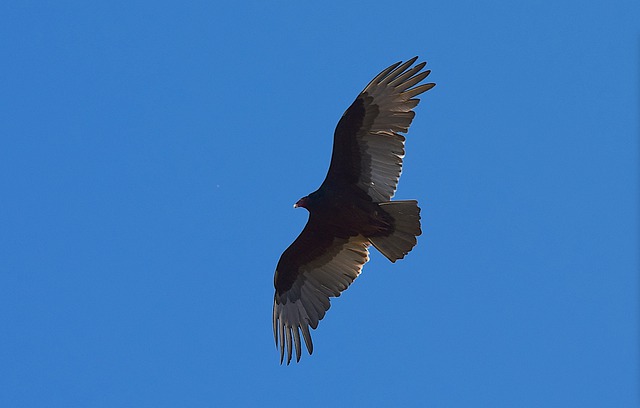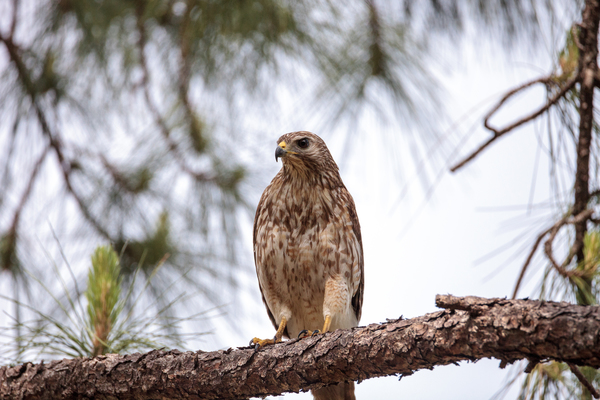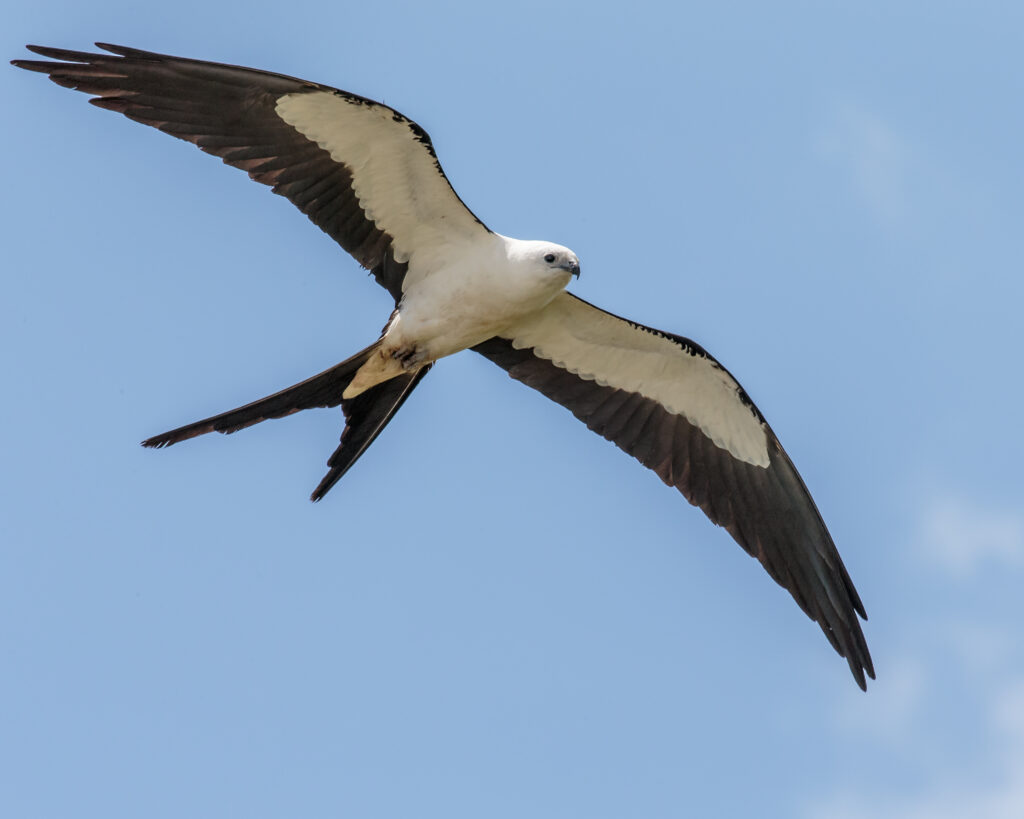From the majestic Bald Eagle soaring high above the lakes to the stealthy Peregrine Falcon diving at lightning speeds, Minnesota is home to a diverse array of birds of prey.
These fierce hunters captivate and inspire us with their remarkable adaptations and powerful hunting skills.
Join us on a journey as we explore the top 11 birds of prey in Minnesota and discover the unique characteristics that make each species so fascinating.
| Image | Name |
|---|---|
 | Ferruginous Hawk |
 | Red-tailed hawk |
 | Osprey |
 | Turkey vulture |
 | Bald Eagle |
 | Great Horned Owl |
 | Peregrine Falcon |
 | Merlin |
 | Northern Harrier |
 | Red-Shouldered Hawk |
 | Swallow-Tailed Kite |
Birds of Prey in Minnesota
1. Ferruginous Hawk

The ferruginous hawk is a huge bird of prey that inhabits the westernmost part of Minnesota and can often be observed circling wide rural regions.
It does have long wings, a huge head that is light in color, red feathers on its top parts, and white feathers on its underparts.
This particular hawk hunts by soaring through the sky and hovering in place, although it also occasionally hunts on the ground.
Although it periodically hops and sprints to grab its food, it isn’t easy to see when it is on the ground. However, it is possible to observe it while it is perched on poles.
Its primary diet consists of a variety of small animals, including rabbits, prairie dogs, and ground squirrels.
It is possible for them to congregate in prairie dog settlements throughout the winter months in order to capture their prey when it rises from their subterranean tunnels.
Other species of raptors, such as bald eagles, may also be interested in these congregations.
The ferruginous hawk consumes not just birds and mammals but also reptiles and rodents.
It is able to select a location for nesting that is as far as 66 feet or as low as the ground surface due to its flexible nesting behavior.
In many cases, it will also rebuild an old nest or take over the nest of an adult hawk or crow.
2. Red-tailed Hawk

The red-tailed hawk is among the raptors that can be spotted the most often across North America.
It is also among the biggest prey birds that can be seen throughout Minnesota.
It is possible to come across it in the open spaces and close to the wooded areas that are located close to towns and farmland.
It has a dark brown upper body with lighter feathers on the underparts.
The hawk gets its name from the cinnamon-colored plumage that is scattered throughout its golden tail.
Female birds are typically roughly 25 % bigger than their male counterparts, with an average weight of 3.7 lbs.
The scream of the red-tailed hawk is a scratchy sound that lasts for around three seconds and is designed to surprise its target.
It will typically consume rodents, birds, mammals, and reptiles for food.
It is unusual that this hawk would come into people’s backyards; thus, the ideal time to look for it is when you are traveling.
The preferred location for a red-tailed hawk nest is high in the crown of a large tree, where the bird can get an unobstructed view of the territory around it.
They are quite territorial and frequently attack other birds of prey, including owls, hawks, and eagles.
3. Osprey

In the summertime, if you find yourself visiting Minnesota, there is a good chance that you may see an osprey flying above the St. Croix River.
Ospreys are enormous prey birds that eat almost exclusively on fish, and they are one of the most common types of raptors found all over the globe.
Ospreys are also sometimes referred to as river hawks or fish hawks.
The upper parts of an osprey are glossy brown, while the underparts and chests are white and patterned.
The females among most species of birds of prey are normally bigger than the males; however, male ospreys are now only slightly thinner than females on average.
It then flies back towards its nest with the fish it has caught after hovering above the water and diving headfirst into the water.
The bird is equipped with thorny patches on the soles of its feet, which allow it to capture slippery fish more.
Ospreys are skilled fishermen, and on average, they bring one fish to their nest every five dives.
The record for the biggest catch ever taken was 2.6 pounds worth of fish.
4. Turkey Vulture

This species of vulture, which is also called the turkey’s buzzard, is among the vultures that may be seen across the New World the most frequently.
Nesting territories for this species extend from the Mississippi River to the St. Croix River throughout Minnesota.
It is a huge black-brown bird of prey, having a redhead that is bare of feathers and a beak that is lighter in color.
This particular vulture is easy to identify because its wings have a distinctive V-shape that can be observed when the bird is in flight.
It has a keen smell sense that enables it to identify the gases created as part of the rotting process, which enables it to discover new corpses by flying low and at a relatively constant altitude.
Even though it doesn’t have a syrinx, the turkey vulture nonetheless hisses sometimes.
It is adapted to living close to human habitation and foraging on dead birds, animals, reptiles, and amphibians in these places.
It is fortunate that it has a robust immune system since this enables it to consume dead animals without being infected with botulism or salmonella.
5. Bald Eagle

The states of Minnesota and Wisconsin are home to the largest bald eagle numbers across all of North America, with the exception of Alaska.
Although it was formerly considered to be in danger of extinction, the population of bald eagles has recently increased because of conservation measures.
The bald eagle has served as the official symbol of the United States since 1782.
It is a prey bird of medium size that mostly consumes fish, and despite its name, it does not have a bald head.
The bald eagle is characterized by having a brown body, a white tail and head, and a pointed, huge, yellow beak.
The average weight of a female bird is approximately 13 lbs, whereas the average weight of a male bird is approximately 10 lbs.
The American bald eagle often soars high in the atmosphere, where it vigorously beats its wings.
It is common for them to build their nests in wooded areas that are close to sources of water since that is where they find their prey.
In most cases, rather than capturing its fish, a bald eagle will pursue and annoy an osprey until the latter gives up its catch.
Additionally, bald eagles are known to take fish from fishing animals as well as human fishermen.
It is not choosy about its food and will consume both living and dead prey.
The diet of the bald eagle includes, in addition to fish, other animals such as reptiles, small mammals, birds, and amphibians.
6. Great Horned Owl

The Great Horned Owl is a species of owl that may be found the most often throughout Minnesota.
It is possible to discover it in a variety of locations, such as the forest areas that border agricultural regions, public parks, industrial development zones, and populated neighborhoods.
The great horned owl, which is also called the tiger owl, has a body that is patchy gray-brown and a face that is reddish in color. It is quite huge.
Its name, which includes the term “horned,” alludes to the huge earlike plumes that lend this raptor its intimidating appearance.
When the bird is lurking among the branches, these tufts make it easier for it to blend in with its surroundings.
Because it is a bird of prey that is active only at night, the ideal time to watch it is just before sunset when it is getting ready to start hunting.
It makes a low-pitched cry that is often comprised of five or six hoots, and it is often spotted perched on tree branches and wooden poles.
When compared to other kinds of raptors, the great horned owl almost certainly possesses the most varied diet.
It consumes a variety of species, some as little as scorpions and others as large as other birds, such as peregrine falcons, ospreys, and many other owls.
It is more likely to locate its prey from a perch, although it is able to pursue it into the bushes if necessary.
7. Peregrine Falcon

In times past, the peregrine falcon, which is now more generally referred to simply as the peregrine, was once named the duck hawk.
It is known for its incredible speed, which might reach to attain to 243 miles per hour during its fast dives as it lowers to grab its prey, making it the most rapid bird on the planet as well as the fastest creature of the animal kingdom.
Because of this, it has gained a lot of notoriety throughout the years.
This falcon has blue-gray upper parts, a black head, and banded underparts; its size is comparable to that of a crow.
It is a bird that likes to nest on cliffs, and the majority of its nesting grounds can be spotted near the Mississippi River and the north side of Lake Superior throughout Minnesota.
However, it may be observed in other parts of the state as well.
When in the air, the peregrine falcon is capable of reaching speeds of up to 55 kilometers per hour (35 miles per hour).
The majority of its diet consists of several species of birds, ranging in size from hummingbirds to sandhill cranes.
Over the course of the last thousand years, mankind has been successfully using this bird as a hunting companion despite the fact that it is among the most common species.
After the 1950s, there was a significant decrease in the population of peregrine falcons owing to the widespread use of pesticides.
Nevertheless, conservation efforts on a global scale proved fruitful, and by the late 1990s, the bird had been removed from the Endangered Species List in the United States.
8. Merlin

The merlin, sometimes known as the pigeon hawk, is a member of the falcon family and is one of the smallest birds of prey in that group.
The female merlin has a brownish color, while the male merlin is grey.
Both sexes possess white bars on the tail and a streaky pattern on their backs.
This raptor nests and hunts along lakeshores in the north-central and northeastern areas of Minnesota.
It may be spotted in both of those regions.
Merlins have become used to the urban environment throughout the course of their history, and a few of them no longer even migrate.
The merlin was commonly regarded as the lady hawk throughout the middle ages, and the birds were employed for hunting skylarks during that period.
Merlins often hunt in groups of two or more, with one animal attacking groups of waxwings from underneath while the second comes up from behind to grab a bird that has been disoriented.
Songbirds and shorebirds make up the majority of the merlin’s diet.
However, in addition to young birds and bats, it is also known to consume larger insects, such as grasshoppers, as a food source.
It does not construct its own nest but rather takes over the nests of other birds, most often magpies and ravens.
9. Northern Harrier

The northern harrier may be seen in various parts of the state of Minnesota, most often in the region close to the northern Great Plains.
Its head resembles that of an owl, and its body is grey with a white underbelly.
Brown feathers are more common in females and young birds than grey ones.
In order to identify and successfully capture its prey, this raptor hunts from a low altitude and relies heavily on both its hearing and visual capabilities.
The contours of the head, together with the stiff facial plumage, contribute to the successful transmission of sound to the ears.
It prefers to eat smaller rodents and animals, but if it captures anything larger, like a duck or a hare, it will attempt to drown it before eating it.
Adult Northern Harriers are far more prone to prey on birds than female Northern Harriers, who often consume rodents and other small animals as their primary food source.
The female of the species is the one who selects the nesting location and constructs the nest mostly on the ground.
It’s possible that the male bird may begin constructing the nest site, but in most cases, the female will organize the nesting material.
The nest of the northern harrier is susceptible to assault by a variety of predators, including dogs, foxes, skunks, crows, raccoons, and badgers, which may take eggs or hatchlings.
10. Red-Shouldered Hawk

It wasn’t until 1935 that the red-shouldered hawk was first documented throughout Minnesota; however, you may now find it living there as a summer visitor.
Male birds typically weigh 1.3 pounds, but female birds may weigh up to 1.6 pounds more than their male counterparts.
This specific hawk’s body is spotted with black and white, and there is red on its chest and wings.
The tip of the tail appears black, and it is striped with white.
Learning to recognize the ascending whistle of the red-shouldered hawk is the most effective method for locating this bird.
Small animals, rodents, and reptiles make up the majority of this bird of prey’s diet. It searches from a ledge or while soaring.
In most cases, the American crow will harass this hawk, but on occasion, both birds may work together to drive away an owl.
Although the great horned owl is known to be a thief, this particular hawk has also been seen to take baby owlets from their nests.
11. Swallow-Tailed Kite

The swallow-tailed kite, which resides across Minnesota’s wetlands and lowland woods, is the biggest species of kite found across North America.
It is also the state bird of Minnesota.
It possesses glossy black feathers with some white linings, mostly on the wings, and its head seems to have a brilliant white color.
It possesses a slender physique, and although being nearly the same height as that of the red-tailed hawk, it’s approximately half the size of the red-tailed hawk.
In order to locate its food, the swallow-tailed kite hovers at a low altitude and makes tight circles over trees.
Because of the acrobatic maneuvers it does when flying, it is possible to spot it, despite the fact that it often flies too high to be seen.
At the conclusion of the summertime, the swallow-tailed kite will make its annual migration to South America.
This particular species of the kite is able to hunt while flying; its prey of choice are often flying insects, which it eats while in flight.
However, it also consumes bats, nestlings, snakes, frogs, lizards, and occasionally fruits. Its diet also includes bats.
Adult swallow-tailed kites often provide their young with smaller vertebrates that the male has captured during their hunting trips.
The female kite will then cut the prey into smaller pieces before feeding it to the baby birds once the male kite has handed it to her.
Conclusion
In conclusion, Minnesota is home to a diverse range of birds of prey, each with unique characteristics and adaptations that make them well-suited to their respective habitats and hunting styles.
From the majestic Bald Eagle to the nimble Merlin, these birds of prey play a crucial role in maintaining a healthy ecosystem and provide a captivating glimpse into the beauty and power of nature.
Whether you’re a seasoned birder or a newcomer to the world of avian wildlife, observing these birds of prey in Minnesota is sure to be a thrilling experience.
So, be sure to grab your binoculars and venture out into the great outdoors to discover the incredible birds of prey that call Minnesota home.
FAQ
What are birds of prey in Minnesota?
Birds of prey in Minnesota are birds that hunt and feed on other animals, such as small mammals, reptiles, and other birds. They are also known as raptors and include species like hawks, owls, eagles, and falcons.
Where can I see birds of prey in Minnesota?
You can see birds of prey in Minnesota in a variety of habitats, including forests, grasslands, and wetlands. Some of the best places to see them are at wildlife refuges and parks, like the Sax-Zim Bog and the Minnesota Valley National Wildlife Refuge.
What is the best time of year to see birds of prey in Minnesota?
The best time of year to see birds of prey in Minnesota is during migration, which typically occurs between late September and early November, and again between late February and early April.
Are there any threatened or endangered birds of prey in Minnesota?
Yes, there are several threatened or endangered birds of prey in Minnesota, including the Peregrine Falcon and the Bald Eagle. Conservation efforts are underway to protect and recover these species.
What should I do if I see a bird of prey in trouble?
If you see a bird of prey in trouble, it is best to leave it alone and contact a wildlife rehabilitation center or a local wildlife biologist for assistance. Interfering with a wild bird of prey can harm both the bird and the person attempting to help it.
Last Updated on March 22, 2023 by Lily Aldrin
